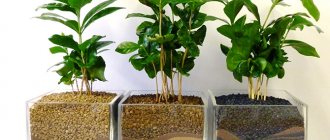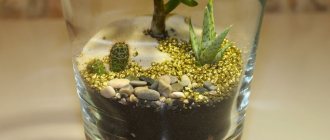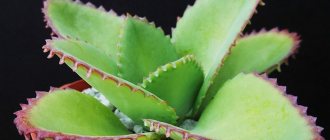Growing an exotic plant at home - a coffee tree - is not as difficult as it seems at first glance. The plant requires certain conditions for care, but they are not fundamentally different from caring for other indoor green spaces.
Coffee drink lovers can name about 20-30 varieties of coffee. But there is only one thing you can grow at home - Arabian. A plant of this species has wavy, smooth oval leaves with a sharp tip.
Placement nuances
The tropical origin of the plant does not mean that it must be placed in a south-facing window under the scorching sun. In excessively hot conditions, the tree runs the risk of not blooming. It is better to protect the plant from direct rays, but organize the lighting carefully.
If the location of the room faces north or west, then the flower is placed on the windowsill. In rooms facing south and east, the pot is removed from the window opening up to 1.5 m.
Be sure to remember that the coffee bush should not change its location. Turn the pot with the “pet” once every five years. To make the formation of the bush symmetrical, it is permissible to install a mirror next to the plant that will not reflect direct sunlight.
Coffee nursery: the first stages of cultivation
In nature, the “strongest” survive: tree sprouts are not protected. On farm plantations things are different. Coffee beans go through a processing stage and are planted in special bags for germination. The resulting sprouts are planted in greenhouse structures to ensure proper care. Some farmers use remote open soils - natural areas instead of greenhouses.
Seedlings reach the level of a young tree in 8-12 months. Then the tree is ready to continue life on the plantation. It is planted in an area that receives plenty of sunlight. Sometimes a place is chosen under the wide crowns of other plantings so that the leaves and flower ovaries do not get knocked down under heavy streams of rain.
Water treatments
To ensure proper care, it is useful to know how to water a flower. The coffee tree needs a sufficient amount of moisture, but will not tolerate liquid stagnation in the soil. This can cause the roots of the plant to rot. This development of events can be counteracted by proper drainage.
Lack of moisture quickly affects the appearance of the tree. The plant becomes lethargic and drops its leaves. Once the soil is moistened, the situation quickly returns to normal.
Watering is carried out according to the schedule:
- in summer every 2–3 days;
- in winter no more than once a week;
- For control, soil drying is tested at a depth of up to 1 cm.
During the warm period, be sure to spray the foliage. This should be done every 1–2 days. To remove dust, the greens can be additionally wiped with a damp cloth. For all water procedures, settled water is used, which is 2-3 degrees higher than the ambient temperature.
Conditions for growing coffee
Depending on how the coffee is grown and what protection methods farmers use, a high yield is achieved.
- Stable climate without seasonal temperature fluctuations. As a rule, plantations are preferred to be located in the equatorial belt.
- Loose soil. Coffee thrives on volcanic slopes thanks to the presence of organic remains.
- Temperature regime. 13-27 degrees Celsius above zero is the acceptable range within which fruits ripen according to schedule.
- Daylight. Trees love abundant but diffused sunlight.
- Sufficient amount of moisture. The area with annual precipitation of 3500 mm is considered the most comfortable.
Are there differences between how Arabica and Robusta coffee grow? The second type is not too whimsical, resistant to fungi. Therefore, breeders began to cross both varieties, creating a hybrid that was less susceptible to disease. This approach reduces the taste and aroma characteristics of the grains and, accordingly, is not in demand.
Choosing soil for a plant
The description of the flower must indicate that it prefers acidic soil. The pH level of the medium should be in the range of 5–5.5. It is easiest to use a ready-made substrate. Blends intended for citrus fruits are ideal for the coffee tree.
You can create soil by combining:
- 1 part peat;
- 2 parts coarse sand;
- 2 parts leaf soil;
- 4 parts manure humus;
- 4 parts of turf.
Additionally, add some crushed sphagnum moss. You can check acidity using litmus paper. If the indicator is violated, the soil must be artificially acidified.
Feeding schedule
Caring for a coffee tree indoors necessarily involves fertilizing. Special complex fertilizers are suitable for this purpose. You can make a solution based on chicken droppings yourself.
Fertilizing is done regularly. In the warm season, this is done about twice a month. In winter, procedures are not carried out more than once every 30 days. When flowering, the tree can be additionally fed with fertilizer containing potassium.
If the foliage begins to fade, then it is permissible to wipe it with lemon juice. Make a solution: a liter of water and 2–3 tsp. citrus squeezes. It is useful to pour the remaining liquid into the soil. It is not recommended to do this procedure more than once a month.
Places of growth
The information most often found on coffee packages is: produced in France, Portugal, Italy, Germany. Such a geographical mark indicates the location of the company, and not the location of the harvest. There are several billion coffee trees growing in the world - plantations are located in tropical Asia and Africa, as well as in the countries of Central and South America, Oceania. Since the areas stretch along the equator, a specific strip is usually called the “coffee belt.”
- Don't miss: Which countries grow the most coffee?
Coffee grows well in a warm and humid atmosphere, where there are no night frosts and sudden temperature changes. The even and mild equatorial climate fully corresponds to the declared parameters. Originating in Ethiopia, coffee spread to regions similar to its ancestral homeland.
Transplantation and formation of a bush
Caring for a coffee tree at home is impossible without regular replanting. The young plant changes its place of residence annually. The tree is moved into a pot that is 5–6 cm larger in diameter than the previous one.
An adult plant over 3 years old requires replanting less often. The procedure is usually performed no more than once every 2–3 years.
It is important to choose the right moment. Transplantation is not done during flowering or fruiting. After harvesting, the right time comes for this procedure.
Coffee trees are replanted using the transshipment method. The plant is moved to a new location along with the existing earthen lump on the roots. Coffee trees are usually planted in groups. As it grows, a lush bush is formed, the crown of which must be decorated. To do this, pruning is done at the end of winter or beginning of spring.
In addition, height restrictions may be required. To do this, pinch the top or perform a constriction. After this, the plant acquires a spherical shape, the crown becomes thick and lush.
Your own coffee harvest from a houseplant
Want to learn how to create a mini coffee garden and how to care for exotic plants? Let's share tips. Growing seedlings yourself is a complex process. It is much easier to buy seedlings at a garden store. Usually they are sold in 5-6 pieces.
When you arrive home, remove the sprouts from the soil and leave the root system in a container with warm water overnight. Plant the seedlings in separate pots with loose soil, providing drainage with pebbles and sand. When the tree reaches a height of 20 cm, it should be transplanted into a larger pot; 50 cm requires a larger container. At 60 cm, an adult plant needs pruning - the growing tip breaks off.
Basic recommendations for care: maintaining humidity, good lighting, absence of drafts, fertilizing the soil (feeding with mixtures for citrus fruits). Statistics show: 1 grown tree with painstaking care produces 200 grams of coffee annually.
Coffee tree propagation
The easiest way to acquire a coffee tree is to purchase a ready-made bush in a store. It is important to carefully evaluate the condition of the specimen. After purchase, the plant is closely monitored for some time, separating it from the rest of the home plantings.
If no negative signs are visible, then the newcomer is transplanted to a permanent place. You can try to propagate an adult plant by separating a cutting from it. To do this, cut off a branch with 2 pairs of leaves. The cut is made approximately 3 cm below the bud.
It is recommended to treat the exposed base with any means designed to stimulate rooting. The branch is placed in moist soil. The seedling is covered with an improvised greenhouse. A hole is left in the bag through which it is regularly irrigated with warm water.
Rooting is considered complete after the appearance of a new pair of leaves. You can also grow a tree from a berry or seed. This process is long, but with the right approach it will be crowned with success.
Landing rules
To grow coffee at home, breeders have developed special varieties. It is recommended to choose from Arabica varieties, for example, the dwarf Nana tree. It grows up to 80 cm in height and blooms twice a year. Robusta (Congo tree) is less demanding, but requires cross-pollination and is more difficult to achieve fruiting at home.
If there is little space in the room, then the Albert variety is more suitable. The Liberian tree grows large, with a pyramidal crown. It requires a large room or greenhouse. But there is also a big plus - it is resistant to many diseases of coffee trees.
Deadlines
Plant the sprouts in pots as soon as the first two leaves appear. Before this, you need to prepare the soil and place drainage material on the bottom of the flowerpot. Cuttings are also planted after the first leaves appear on them. The event is carried out in late spring, when the soil is well warmed up, or in the summer. Seedlings can be immediately planted in open ground, but it is recommended to keep them in a greenhouse for a month.
Preparing the pot and soil
Initially, sprouts can be grown in small plastic cups. Then the pot is selected depending on how developed the roots are. It is not recommended to replant the tree immediately into a large pot.
You need a pot volume larger than the root ball by 2-4 cm. Otherwise, they will begin to rot, as the soil will sour.
For growing, it is best to buy ready-made soil for citrus fruits in specialized stores. The coffee tree loves slightly acidic, clayey soil rich in organic matter.
You can prepare the soil yourself by mixing (parts of the proportion):
- peat (1);
- river sand (2);
- garden soil (2);
- manure with humus (4);
- crushed sphagnum moss (4).
Or mix all ingredients except moss in equal parts. Also suitable soil is soil for azaleas and gardenias. Additionally, prepare a drainage layer (for example, a mixture of coarse river sand with nut shells), which is poured onto the bottom of the tub.
Landing technology
More often, coffee trees are planted by cuttings. Before planting, their roots are kept in a Heteroauxin solution for 3 to 5 hours. The soil is disinfected with a solution of potassium permanganate. The cutting is immersed vertically in the ground, 2.5 cm. Then the ground is watered again with a solution of potassium permanganate. Cover the top with a large plastic bag with holes.
They serve for aeration and spraying until the cuttings take root well. The pot is placed in a place with diffused light. The room temperature is maintained from +25°C to +30°C. As soon as the true top leaves appear on the branches, they are transferred to freer pots. The original diameter is 12 cm.
The shard is thrown onto the bottom with the convex side up. A centimeter layer of coarse sand is poured onto it. Then the cutting, pulled out together with a lump of earth, is placed on top and covered with soil. For 10 days the pot is placed on a window on the north side. Then you can move it to a permanent place.
If seedlings are taken, they are first placed in greenhouses for 6-12 months, when it grows to 30 cm. Then they are transplanted into well-warmed soil. The area should be illuminated and protected from the wind.
Diseases and difficulties in growing
Proper care at home usually does not lead to tree disease. The only thing is that greens can be attacked by spider mites. The fight against it is carried out using special drugs. Operate according to instructions.
Other painful conditions are usually associated with improper care. Each condition should be considered separately, its causes should be understood, and the conditions should be adjusted accordingly.
Looking at the photo of a coffee tree, it becomes clear how impressive this plant is. It will be an excellent addition to any interior. In this case, this option will not cause trouble when growing.
Flowering and ripening
The coffee tree blooms for a very short period of time - as soon as the rainy season begins. The flowers fade after pollination, so they last up to 2 days, but fill the plantation with the sweetish aroma of jasmine. The pleasant smell attracts bees - pollination occurs naturally.
The uniqueness of the process lies in the structure of the flowers. There are two types of coffee: Congolese (Robusta) and Arabian (Arabica). The latter has bisexual flowers with a stamen and pistil - the plant can be pollinated with the participation of bees, but self-pollination is also possible. To pollinate robusta, you will need two trees, since they are self-sterile, although bisexual. In this case, pollen transfer occurs with the help of wind and without the participation of bees.











